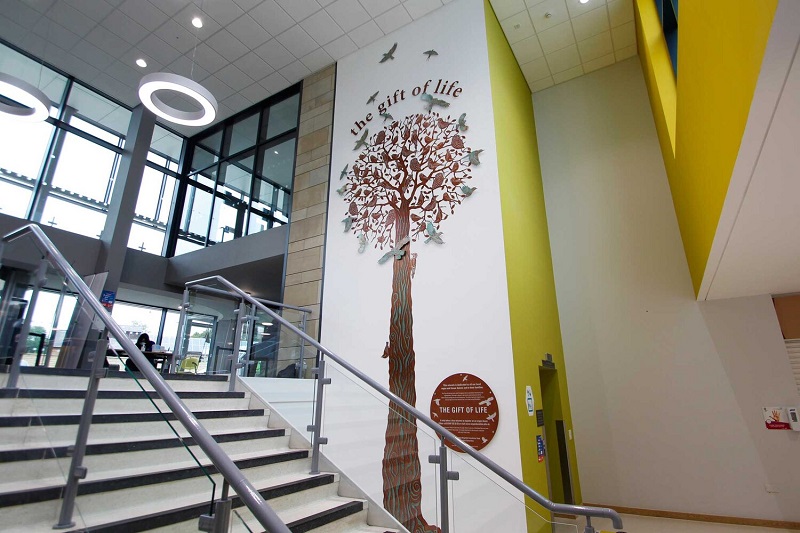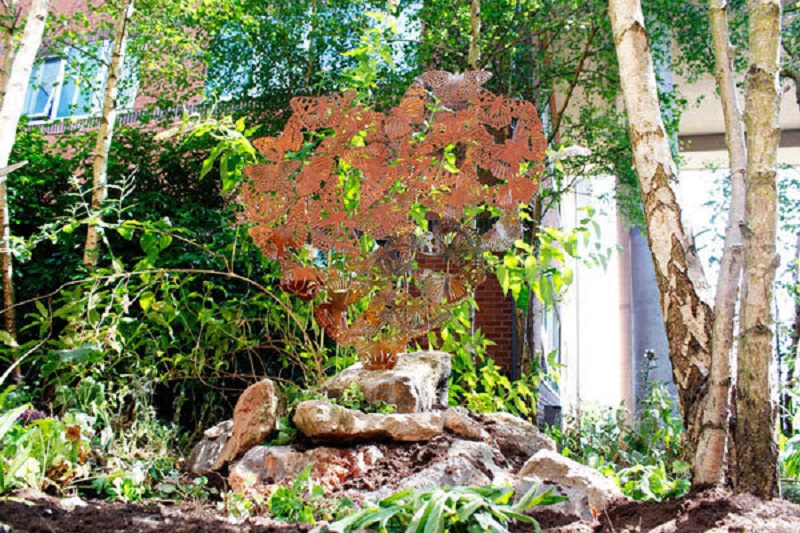Earlier this month charities and healthcare providers across the country publicised National Organ Donation Week, doing everything they could to encourage people to join the donor register.
But hospitals have been taking this effort a step further in recent years, using public artwork to draw attention to the issue, and to acknowledge those people who have donated their organs to save the lives of others.
Hospital Art Studio is leading this new trend, having worked on a number of arts projects at UK hospitals, including at Yeovil District Hospital, Medway Hospital in Kent, Winchester and Basingstoke Hospital, and Derriford Hospital in Plymouth, among others.
And three of its projects were launched in the run up to this week's national awareness event.
During this year, with the coronavirus outbreak, acknowledging the importance of organ donation has been more significant than ever
The Sails and Seabirds installation at University Hospital Southampton was produced in conjunction with ImageCo and Onsite Print Installations, and was completed last week.
Like many similar projects, the designers looked at local landmarks and locations on which to base the artwork.
In this case, with Southampton famous for hosting the biggest water-based boat show in Europe, and the many varieties of seabirds which congregate around the estuaries and mudflats; the work depicts gulls soaring around an abstract representation of wind-blown sailing ships.
This also represents the freedom given by the organ donation, often referred to as the ‘gift of life’.
Located in main entrance to the hospital, all the birds are decorated in bright sky patterns as they flit among the sails, in colours reminiscent of early summer days – from stormy blues and sea-reflected turquoise, to sunset pinks and purples.
Their feathers and other features are picked out in glistening aluminium so they shimmer in various lights throughout the day.
And every bird is fitted with hidden spacers to give a shadowy depth.
Another recent installation was a Tree of Yorkshire Birds at Bradford Royal Infirmary.
Once again located in the main atrium space, the life-size ‘tree of life’ is 8m tall and fills a wall three floors high.
It was inspired by a poem written by Karen van de Bospoort, partner at Hospital Art Studio, and was created in aged copper, depicting its autumn state.
The birds flying around the exterior of the tree appear in brighter-coloured verdigris metal, fitted with hidden spacers for depth, symbolising those who have received a new organ and can therefore escape from the confines of their declining health.
The team chose birds native to rural areas around the city, including blue tits, great spotted woodpeckers, little owls, long-tailed tits, nuthatches, swallows, thrushes, and wrens.
Caroline Mitchell, sister of Emmerdale actress, Kitty McGeever, who passed away at Bradford Royal Infirmary five years ago while waiting for a second organ transplant, said installations such as these were important to spread the message about the importance of organ donation and to recognise donors.
Following Kitty’s death, her organs were donated to save the lives of others.

Tree of Yorkshire Birds again recognises the local wildlife and fills a wall three floors high in the main entrance area
Speaking about the impact of the Bradford project, Caroline said: “The memorial is a beautiful reminder of the generous gift that my sister and so many thousands of organ donors have made so that someone else may live a happy and healthy life after their death.
“The tree and cycle of birth and death felt very fitting and signify the ongoing life force that continues because of organ donation long after our loved ones pass away.
“We as a family are grateful to Bradford Royal Infirmary for remembering and acknowledging the selfless acts made by so many families and their much-loved relatives who have tragically had their lives cut short.
“It is really very beautiful and life affirming.”
We research local landscapes, such as woodlands, rivers and estuaries, and coastal environments, to draw out something that can be utilised to create an artwork that will be unique, but relevant
And the final recent installation was at Salisbury District Hospital, where the team has unveiled a sculpture in the garden of remembrance.
The freestanding work features a kaleidoscope of butterflies congregating into a heart shape – a metaphor for ‘the Gift of Life’.
Working with BJ Fabrications, the team cut the sculpture from a single piece of copper, securely mounted into a large weathered rock so it appears as if the butterflies are fluttering in mid air.
At 1m high, it is lifted 2m off the ground by a discreetly-constructed ‘rockery’ that will be covered by low-growing vegetation over time.

Also unveiled by Hospital Art Studio in the run up to National Organ Donation Week was this outdoor installation at Salisbury District Hospital
Speaking to BBH about the use of art to encourage organ donation, Tony van de Bospoort, partner at Hospital Art Studio, said: “During this year, with the coronavirus outbreak, acknowledging the importance of organ donation has been more significant than ever.
"And, as National Organ Donation Week this year had to take place predominantly online, it was vital that hospitals around the country had something distinctive to publicise their message.
"Artwork is an excellent medium to portray the importance of organ donation.
"A wall-filling artwork or sculpture can get the message across far more succinctly than a written leaflet or words on a brass plaque.
"And an artwork of scale that greets people as they enter a hospital will draw them in to examine more closely and understand essentially what the artwork is communicating.
"We also are mindful of creating a memorial to all those who have lost their lives and have donated organs in order for others to continue their lives."
And basing the design on the local area is often key, he added.
As National Organ Donation Week this year had to take place predominantly online, it was vital that hospitals around the country had something distinctive to publicise their message
"We feel it’s essential to create an organ donation artwork of relevance to the area of Britain where the particular hospital is located.
"Our designs are based on the natural environment, as organ donation is all about life!
"We research local landscapes, such as woodlands, rivers and estuaries, and coastal environments, to draw out something that can be utilised to create an artwork that will be unique, but relevant.
"At times we have also utilised the natural world in a metaphoric way to describe a local industry or manufactured item."
